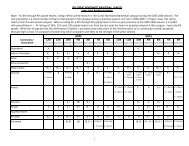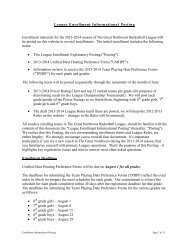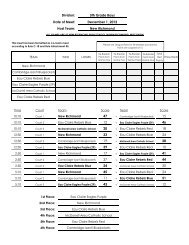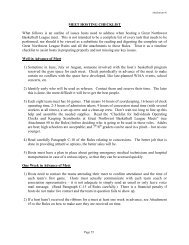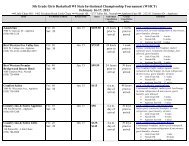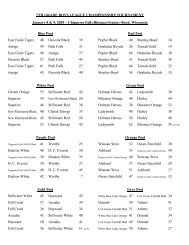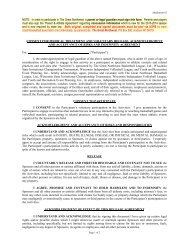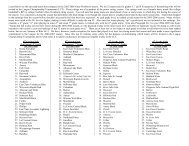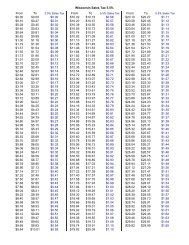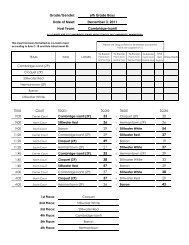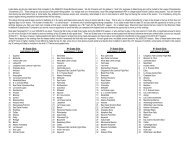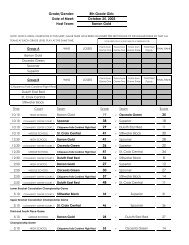THE GREAT NORTHWEST BASKETBALL LEAGUE
THE GREAT NORTHWEST BASKETBALL LEAGUE
THE GREAT NORTHWEST BASKETBALL LEAGUE
You also want an ePaper? Increase the reach of your titles
YUMPU automatically turns print PDFs into web optimized ePapers that Google loves.
2011-2012 Season<br />
GNBL Rules<br />
The 2012 WSICT will have an 80-90 team field each for grades 6, 7 and 8 (depending on gym<br />
capacity of the host communities), with separate fields for WIAA Division 1, 2 and 3 teams;<br />
Division 4 and Division 5 will play in a combined field. At most WSICTs, we have too few<br />
Division 5 teams to sustain a separate field, so Division 4 and 5 communities are combined. The<br />
5 th grade fields are usually somewhat smaller with 70-76 teams in each grade/gender. The<br />
WSICT will not be open to our Minnesota members, who have their own State Tournament in<br />
early March. Over 680 teams state-wide participated in the WSICT in the spring of 2011.<br />
The League helps organize this tournament to provide our top Wisconsin-based teams the ability<br />
to play the top teams from communities their size from across the State of Wisconsin.<br />
Approximately 25-30% of the WSICT field comes from Great Northwest League membership,<br />
with the remaining teams selected from the best teams in other regions of the state. The Great<br />
Northwest invests many hours working with other traveling leagues around the state, and major<br />
tournament directors, in identifying and recruiting top teams from outside our League, the cost of<br />
which is covered by the WSICT entry fee:<br />
• Invitations are extended to League teams that are the highest ranked teams in the League's<br />
annual power rating at their community size. The top five or six League members in each of<br />
the four Divisions are guaranteed a spot, and highly-ranked teams just below that level are<br />
invited to apply subject to space availability. For Division 1 teams, typically an "A" rating is<br />
necessary to make the field. Division 2 teams making the field are typically "A" teams or<br />
higher level "B+" squads. For Division 3, an "A" or "B+" rating is required. Occasionally, at<br />
the Division 4/5 level, a high "B" rating is sufficient, but most of these teams also have a<br />
"B+" or better rating.<br />
• To be eligible for the 2012 WSICT, programs in the area covered by the League must be<br />
League members, with individual teams playing in at least three League meets during the<br />
current season (2011-2012). League and any non-League competition must be at the "A/B+"<br />
level so that the team can validate that it is strong enough to compete effectively in the<br />
WSICT.<br />
• Preferential treatment will be given to League teams that attended the previous season's<br />
WSICT and performed well, over a League team that is similarly-ranked, but declined to play<br />
in the previous season's WSICT.<br />
• Preferential treatment for the 2012 WSICT will also be given to teams that were invited to,<br />
attended and performed well at, the 2011-2012 League Championship Tournament.<br />
• Programs residing inside League boundaries, but who fail to participate in The Great<br />
Northwest, will not be included in this field.<br />
C) Meet Organizational Issues<br />
1) Roster Options. Each team will be allowed to carry as many players on its roster as it wants.<br />
However, a maximum of 12 individual awards will be available to each eighth through fourth<br />
grade team at each meet. If a team has more than 12 players at a given meet, the head coach will<br />
be given all of the individual awards and be responsible for determining who receives them and<br />
who doesn't. Teams with more than 12 players on their roster are encouraged to rotate the players<br />
they actually bring to each meet so that there aren't so many players on the bench, which will<br />
work to decrease the number of mass substitutions and shorten the running time of games.<br />
Conversely, teams are expected to have sufficiently large rosters, or have access to players at a<br />
younger grade level who can be moved up when needed, so that one or two injuries or illnesses<br />
14



